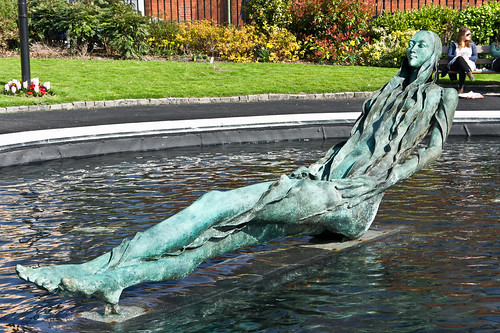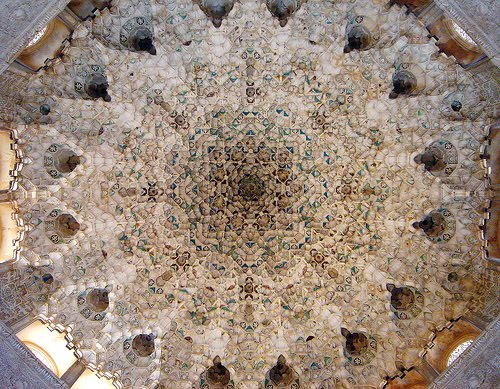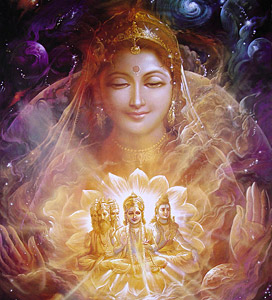We have to had them whether we’ll like it or not. They’ll have to have us now then we’re here on theirspot. Scant hope theirs or ours to escape life’s high carnage of semperidentity by subsisting peasemeal upon variables. Bloody certainty have we got to see it ere smellful demise surprends us on this concrete that down the gullies of the eras we may catch ourselves looking forward to what will in no time be staring you larrikins on the postface in that multimirror megaron of returningties, whirled without end to end. (p.582)
The Wake for the end of history continues on. It is a "collideorscape," a kaleidocosm, all times and places, people and events, shifting in rainbow colours at once. A bang at the gate. A shout in the street. A letter written in the indelible ink of piss and shit, stamped and signed with a jism stain and pecked out of an archaic midden mud-heap by the mother goddess hen.

Cock and Biddy
The Wake has two main layers, each striated into many sub-accretions. These are called HCE and ALP -- standing for, from one perspective, Humphrey Chimpden Earwicker and Anna Livia Plurabelle. Both of these layers make up the dream of the Wake, a couple sleeping foot to head, a sixty-nine, yin-yang position spiraling out the form of the nightmare.
HCE is ultimately, along with many other things, the creator god. He is Atum who has crafted the lesser gods and the rest of the world by spunking on the primordial mud pile. His boasts that he alone has created the universe are betrayed by his thunder-like stuttering. Deep down he feels the guilt of arrogating to create without acknowledging the Mother. This is the first great Fall and all other falls follow from this original sin.

He is the blind Demiurge, Ialdabaoth, his guilt causing a split within himself both between old and new and right and left. The whole nightmare of history is the unfolding drama to attempt to assuage this guilt -- a war of sons against fathers, brothers against brothers, all futilely trying to possess and conquer their wife/mother/daughter/sister. Finnegans Wake is the last act of this drama which can only end with the Goddess' love and forgiveness after all is surrendered to Her.
ALP is this goddess. She is the River that runs through and beyond all space and time. Joyce is the creator of the Wake, in which he aimed to contain the entire cosmos, but ultimately he humbles himself completely before the Goddess. The whole book is intricately structured and layered with meticulous and manic attention to detail, but it is all kept entirely open.

All chance, all synchronicity, all unpredictability, all unintended meanings are allowed to flow through it. But "allowed" is not the right word -- in complete surrender to the River, Joyce gave himself no choice. He entirely offered himself as a sacrifice to the Muse, manifested by his mother, his wife Nora, and his schizophrenic yet sparkling and dancing daughter, Lucia. ALP is the reason why all can be found in the Wake -- everything within Nature and Imagination bubbles and ripples through it.
Letting The Pieces Play
The Humpty Dumpty of tradition has fallen off the wall. God is dead. Modernism attempts to put the pieces back together again, although presumably in a way that is more rational and just. Like the King's men and horses it inevitably fails -- the process of constructing and falling anew only accelerates. Finally, postmodernism gives up. It "plays with the pieces." The modernists and old traditionalists snort in disgust. It seems to be pure nihilism.

But then something magical occurs. The pieces begin to organize themselves. A complex, chaotic order forms its own patterns, without centre and without control.
This is where ALP flows. This is the fully anarchic free market gift economy of the Gaian mind bound to replace all modernist models, both capitalist and socialist, of attempted economic and political control.
This involves a new paradigm of language, one discovered in the Wake. Beyond Ferdinand Saussure's view of language, taken up by the structuralists and the post-structuralists, as being a synchronic network of difference is his disconcerting discovery of hidden anagramic layers of meaning throughout Latin and other poetry. From this, he reluctantly realized that the emergence of unintentional meaning might well up and be present within all texts. This is ALP. This is what is beyond the post-modern.
Perhaps every text is an open text, as Umberto Eco termed it. Definitely all "sacred" texts seem to be so. Norman O. Brown claimed that only the generation of Westerners able to grasp the full significance of the Wake could ever hope to understand the Koran. Only now can we find the strands of Indra's Net through all works.

Mohammed countered his critics by claiming that it was impossible for the Koran to be a forgery because only Allah could compose a book so complex and perfect. Mohammed challenged anyone to try anything similar. Joyce took up the challenge and met it with the Wake. Both Allah and Joyce are names for the Creator of the universe.
In Joyce's testament, however, the God seeks forgiveness. Joyce names 111 of the 114 books of the Koran and refers specifically to Sura 18, "The Cave," which is called the Islamic Apocalypse. This Sura also has 111 lines (including the title) and it introduces Al Khidr -- Elijah, the Wandering Jew, the Green Man, Osiris, the Green Face -- ultimately the consort and messenger of the Goddess. Instead of "Allah the All Merciful," Joyce addresses his chapter to "Annah the Allmaziful." Annah is the archaic White Goddess, also the mother of Mary.

ALP equals 111 in gematria, and this is her number. The books of the Koran are thus sacrificed in flames to her. Robert Anton Wilson, who often signed his writing with his initials RAW, also became obsessed with the number 111 through his study of the Wake. This is what he writes in his book Coincidance:
This 1:11 business turns out to be more curious than we realize at first, even if we note that it is connected with Bloom's son, who died at age 11 days, Shakespeare's son Hamnet who died at 11 years and the 22 (2x11) letters in the Hebrew alphabet or the 22 words in the first sentence of Ulysses. If ALP and APL invoke all this, the LAP, a further permutation, invokes the LAP where a Freemason wears his apron, as in Aleister Crowley's BOOK OF LIES, Chapter 54, in which some Freemasons guess that the lost Mason Word is AMO, whose number is 111, and some guess that it is LAP which also has the number 111. (By Cabala, AMO=A which is 1, M which is 40, and O which is 70, 1+40+70=111, while LAP=L or 30, A or 1, and P or 80, and 30+1+80=111.)
William York Tindall, a Joyce scholar who likes to count, has noted that many long sentences in FW have 111 clauses. Anna Livia Plurabelle's untitled "mamafesta" in Chapter Five has 111 alternative titles; when sad, she is described as "wan wan wan"; in Chapter 8, she has 111 children. Most books on Cabala hint at trancendental meanings in the fact that the Hebrew A or aleph=ALP=111 when spelled in full as aleph-lamek-pe.

It seemed to be no coincidence to his followers, therefore, that Wilson died on 1/11/07. What is weirder, though, and definitely a manifestation of the playful flow of ALP, is the fact that his initials RAW appear four times in a row on page 111.
...peraw raw raw reeraw puteters out of Now Sealand in spignt of the patchpurple of the massacre, a dual a duel to die to day, goddam and biggod, sticks and stanks, of most of the Jacobiters...
Happy Sins
Also on page 111 is the first appearance of the Letter, which is the Wake itself, signed at the end with a tea stain. The very last word of the Wake, usually seen as joining the first sentence and so creating an endless loop, is "the." Thé in French is of course tea. This is the tea stain. The tea or "T" is also the Tunc page of the ancient Irish manuscript, The Book of Kells -- which Joyce somehow claims was inspired by the Wake.
Many scholars assert that the Tunc page contains the whole mystery of The Book of Kells and that it points to active pagan survivals, most notably the serpent cult, within the pre-Roman Catholic, Celtic Church. The Tunc page, with its large illustrated T, represents Christ on the Cross flanked on either side by the two thieves. For Joyce, the Cross is his final the, thé or T, the two thieves are Shem and Shaun, and Tunc is also the ever-giving, ever green and fertile cunt of the Goddess. A new theology is created.

Joseph Campbell, who really began his career by writing the first full-length book on trying to decipher the Wake, called the Tunc page the key to unlocking the Wake. Campbell writes in his Occidental Mythology,
The so-called Tunc-page, bearing the words of the Gospel according to Matthew: "Then there were crucified with him two thieves" (Tunc cru/cifixerant/XPI cum eo du/os la/trones).
We recognize the cosmic self-consuming, self-renewing serpent, whose lion-head recalls the old Sumerian lion-bird, while the T of the word Tunc is a lion with serpentine attributes, either swallowing or emitting (or both) a tangled pair-of-opposites. The serpent, as we have learned, is generally symbolic of both the self-consuming and self-renewing powers of life; the lunar mystery of time, while the lion is the solar power, the sun door to eternity. The circumscribing serpent, therefore, is the demiurgic, world-creating and -maintaining principle, or, in the Gnostic-Christian view, the God of the Old Testament, while the lion of the T is the road of escape from this vale of tears: the "way and the light," that is to say the Redeemer.
The Greek letters XPI, inserted in the text after crucifixerant, are the signa of Christ (Greek Χριστός ). The same three letters furnish the base of the whole design, as appears when the page is turned clockwise, to lie on its right side. In this position, the great initial unites with the central bar to form P: the middle letter of the sign, symbolizing the Savior between the two thieves, which latter now are represented by the X and I, and thus one with -- indeed parts of -- XPI, or Christ.
The Book of Kells was itself the most famous, most brilliant example of Irish illuminated manuscripts composed during the 700 years of the Celtic Church. This church lasted from the arrival of St. Patrick in 432 AD to St. Malachy's establishment of the Roman liturgy along with his archbishophoric in Armagh in 1132.

1132 is another number which pops up throughout the Wake. Certainly the 11 represents completion and return after the sequence of 1 through 10, and the 32 is the number of feet per second that objects fall through the air. It also represents the Fall and the Resurrection, Campbell points out, as explained in Romans 11:32.
For God hath concluded them all in unbelief, that he might have mercy upon all.
This verse introduces the doctrine of the happy sin, or felix culpa -- the original Edenic Fall being happy because it actuated Christ to come and redeem humanity. Joyce alters "felix culpa" to "phoenix culprit" -- the guilty person, HCE, of the incident at Phoenix Park, which is both Eden and the ever burning and rising phoenix of ancient myth.
It is obvious, though, that 1132 refers to the history of Ireland as well. St. Malachy effectively ended the relatively autonomous Celtic Church and, in the same year, the Abbess of Kildare was raped and deposed from power. The Abbess was the representative of St. Brigid, who was a contemporary of St. Patrick. St. Brigid, in turn, is the Christian transformation of the Celtic goddess, Brigid. Both St. Brigid and Brigid share the same feast day at Imbolc, the First or Second of February, which is also Joyce's birthday.

Thus in 1132, the female and pagan elements of Christianity in Ireland were effectively overthrown and patriarchal, direct rule from the Vatican was established. This marked a huge tragedy for Joyce. There is more to the story, though. St. Malachy is attributed as writing the Prophecy of Popes, forgery or not. This is a poem of 111 lines. Each line represents a verse for every pope following and including Celestine II, the reigning pope when Malachy first had his prophetic vision.
Joyce directly refers to this prophecy in the Wake and notes the connection of the 111 popes with the 111 of ALP. The end of the list, sometimes concluding with a 112th pope, Peter the Roman, is seen as marking the end of Roman Catholic Church and the start of the Final Judgement. Did Joyce view this ending as marking the return of Brigid?
(secunding to the one one oneth of the propecies, Amnis Limina Permanent) (p.153)
It is interesting that the 111th pope is in the Vatican right now -- Pope Benedict XVI who in the prophecy is named as "the glory of the olives." Is the Wake, then, a prophecy about the present?

Sleeper Awakening
In previous posts this blog has noted the possible awareness that Joyce had of the Rosicrucian 108-year cycle, particularly that of 1904 to 2012. Joyce does not write anything explicitly about 108 years, although there are several references to 432 (108x4) in the Wake. In Ulysses, on the other hand, during the "Ithaca" chapter Joyce includes several numbers which sum to 108 -- just as Homer includes a list making up of 108 suitors in the Odyssey.
Stephen wrote the Irish characters for gee, eh, dee, em, simple and modified, and Bloom in turn wrote the Hebrew characters ghimel, aleph, daleth and (in the absence of mem) a substituted qoph, explaining their arithmetical values as ordinal and cardinal numbers, videlicet 3, 1, 4, and 100.
Readers of this blog will note the Hebrew letters Gimel and Daleth, connected to the 13th path of the Tree of Life and the gateway of Da'at. The numbers 3.141, or pi, will come up in a subsequent post making a deeper reading of the Wake. An earlier post noted that this year, 2012, is also 1132 according the traditional Nepali sambat calendar. Whether Joyce was conscious of any of this, or whether this only emerges from the mysterious substratum of ALP, the connections can be found.
In any event the "story" of Finnegans Wake, like Crowley's writings from 1904, includes the rebirth of Osiris as Horus and the dawn of a New Aeon, the rising from sleep into the morning Sun.
The eversower of the seeds of light to the cowld owld sowls that are in the domnatory of Defmut after the night of the carrying of the word of Nuahs and the night of making Mehs to cuddle up in a coddlepot, Pu Nuseht, lord of risings in the yonderworld of Ntamplin, tohp triumphant, speaketh. (p.593)

Did Joyce also know about the end of the Mayan calendar in 2012? Whether he was writing on the intentional level of HCE, or he was acting as an unconscious channel of ALP, the world maya is mentioned a significant seven times within the Wake. Seven is significant because it is the number of colours in the holographic rainbow kaleidoscope that is personified by the seven Rainbow Girls. The maya references are more clustered towards the end, towards the awakening, with three in the last chapter and two of these in the last few pages.
Obviously maya is also associated here with both the Hindu idea of illusion, also the veil of Isis, and the mother of the Buddha. But these references are almost invariably coupled with the statements about the end of time, about awakening, about the coming of ALP the Goddess.
Where did thots come from? It is infinitesimally fevers, resty fever, risy fever, a coranto of aria, sleeper awakening, in the smalls of one's back presentiment, gip, and again, geip, a flash from a future of maybe mahamayability through the windr of a wondr in a wildr is a weltr as a wirbl of a warbl is a world...... (p.597)

But you're changing, acoolsha, you're changing from me, I can feel. Or is it me is? I'm getting mixed. Brightening up and tightening down. Yes, you're changing, sonhusband, and you're turning, I can feel you, for a daughterwife from the hills again. Imlamaya. And she is coming. Swimming in my hindmoist. (p.627)
A flash from a future of maybe. And she is coming. This resonates well what many also associate with the turn of the Mayan great cycle in 2012. Do we wake this year?
https://books.google.it/books?id=qEQQht2Y2CQC&pg=PA108&lpg=PA108&dq=number+111+qutb&source=bl&ots=GMVeYg_bNO&sig=iaSXUutpdV03d7kknzFt3bDXY30&hl=it&sa=X&ved=0ahUKEwjxr76f2eXVAhWC7BQKHV08AAAQ6AEIHDAA#v=onepage&q=number%20111%20qutb&f=false
ReplyDelete